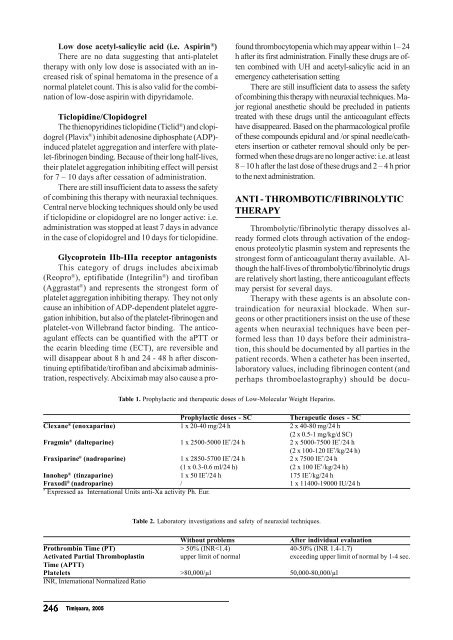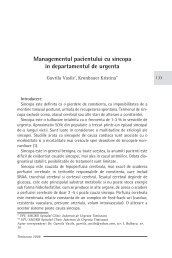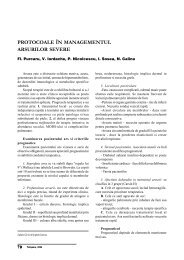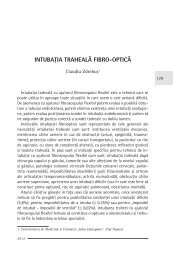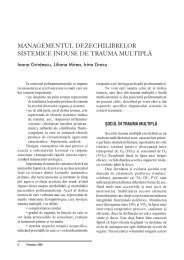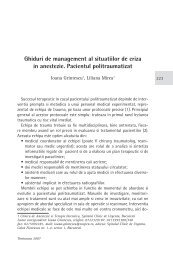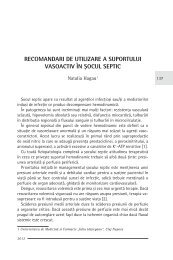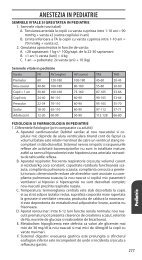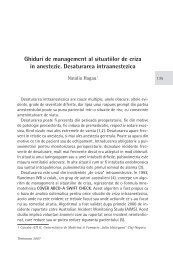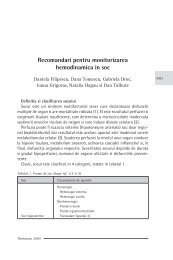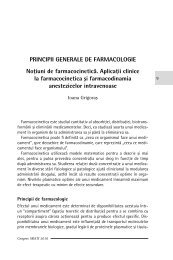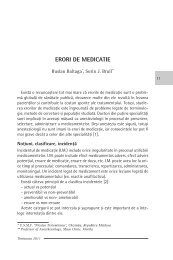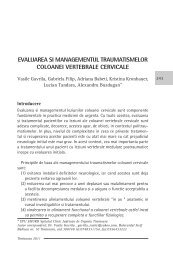Algoritm de diagnostic si tratament in infectiile fungice in
Algoritm de diagnostic si tratament in infectiile fungice in
Algoritm de diagnostic si tratament in infectiile fungice in
You also want an ePaper? Increase the reach of your titles
YUMPU automatically turns print PDFs into web optimized ePapers that Google loves.
Low dose acetyl-salicylic acid (i.e. Aspir<strong>in</strong> ® )<br />
There are no data suggest<strong>in</strong>g that anti-platelet<br />
therapy with only low dose is associated with an <strong>in</strong>creased<br />
risk of sp<strong>in</strong>al hematoma <strong>in</strong> the presence of a<br />
normal platelet count. This is also valid for the comb<strong>in</strong>ation<br />
of low-dose aspir<strong>in</strong> with dipyridamole.<br />
Ticlopid<strong>in</strong>e/Clopidogrel<br />
The thienopyrid<strong>in</strong>es ticlopid<strong>in</strong>e (Ticlid ® ) and clopidogrel<br />
(Plavix ® ) <strong>in</strong>hibit a<strong>de</strong>no<strong>si</strong>ne diphosphate (ADP)-<br />
<strong>in</strong>duced platelet aggregation and <strong>in</strong>terfere with platelet-fibr<strong>in</strong>ogen<br />
b<strong>in</strong>d<strong>in</strong>g. Because of their long half-lives,<br />
their platelet aggregation <strong>in</strong>hibit<strong>in</strong>g effect will per<strong>si</strong>st<br />
for 7 – 10 days after cessation of adm<strong>in</strong>istration.<br />
There are still <strong>in</strong>sufficient data to assess the safety<br />
of comb<strong>in</strong><strong>in</strong>g this therapy with neuraxial techniques.<br />
Central nerve block<strong>in</strong>g techniques should only be used<br />
if ticlopid<strong>in</strong>e or clopidogrel are no longer active: i.e.<br />
adm<strong>in</strong>istration was stopped at least 7 days <strong>in</strong> advance<br />
<strong>in</strong> the case of clopidogrel and 10 days for ticlopid<strong>in</strong>e.<br />
Glycoprote<strong>in</strong> IIb-IIIa receptor antagonists<br />
This category of drugs <strong>in</strong>clu<strong>de</strong>s abciximab<br />
(Reopro ® ), eptifibati<strong>de</strong> (Integril<strong>in</strong> ® ) and tirofiban<br />
(Aggrastat ® ) and represents the strongest form of<br />
platelet aggregation <strong>in</strong>hibit<strong>in</strong>g therapy. They not only<br />
cause an <strong>in</strong>hibition of ADP-<strong>de</strong>pen<strong>de</strong>nt platelet aggregation<br />
<strong>in</strong>hibition, but also of the platelet-fibr<strong>in</strong>ogen and<br />
platelet-von Willebrand factor b<strong>in</strong>d<strong>in</strong>g. The anticoagulant<br />
effects can be quantified with the aPTT or<br />
the ecar<strong>in</strong> bleed<strong>in</strong>g time (ECT), are rever<strong>si</strong>ble and<br />
will disappear about 8 h and 24 - 48 h after discont<strong>in</strong>u<strong>in</strong>g<br />
eptifibati<strong>de</strong>/tirofiban and abciximab adm<strong>in</strong>istration,<br />
respectively. Abciximab may also cause a profound<br />
thrombocytopenia which may appear with<strong>in</strong> 1– 24<br />
h after its first adm<strong>in</strong>istration. F<strong>in</strong>ally these drugs are often<br />
comb<strong>in</strong>ed with UH and acetyl-salicylic acid <strong>in</strong> an<br />
emergency catheterisation sett<strong>in</strong>g<br />
There are still <strong>in</strong>sufficient data to assess the safety<br />
of comb<strong>in</strong><strong>in</strong>g this therapy with neuraxial techniques. Major<br />
regional anesthetic should be preclu<strong>de</strong>d <strong>in</strong> patients<br />
treated with these drugs until the anticoagulant effects<br />
have disappeared. Based on the pharmacological profile<br />
of these compounds epidural and /or sp<strong>in</strong>al needle/catheters<br />
<strong>in</strong>sertion or catheter removal should only be performed<br />
when these drugs are no longer active: i.e. at least<br />
8 – 10 h after the last dose of these drugs and 2 – 4 h prior<br />
to the next adm<strong>in</strong>istration.<br />
ANTI - THROMBOTIC/FIBRINOLYTIC<br />
THERAPY<br />
Thrombolytic/fibr<strong>in</strong>olytic therapy dissolves already<br />
formed clots through activation of the endogenous<br />
proteolytic plasm<strong>in</strong> system and represents the<br />
strongest form of anticoagulant theray available. Although<br />
the half-lives of thrombolytic/fibr<strong>in</strong>olytic drugs<br />
are relatively short last<strong>in</strong>g, there anticoagulant effects<br />
may per<strong>si</strong>st for several days.<br />
Therapy with these agents is an absolute contra<strong>in</strong>dication<br />
for neuraxial blocka<strong>de</strong>. When surgeons<br />
or other practitioners <strong>in</strong><strong>si</strong>st on the use of these<br />
agents when neuraxial techniques have been performed<br />
less than 10 days before their adm<strong>in</strong>istration,<br />
this should be documented by all parties <strong>in</strong> the<br />
patient records. When a catheter has been <strong>in</strong>serted,<br />
laboratory values, <strong>in</strong>clud<strong>in</strong>g fibr<strong>in</strong>ogen content (and<br />
perhaps thromboelastography) should be docu-<br />
Table 1. Prophylactic and therapeutic doses of Low-Molecular Weight Hepar<strong>in</strong>s.<br />
Prophylactic doses - SC<br />
Therapeutic doses - SC<br />
Clexane ® (enoxapar<strong>in</strong>e) 1 x 20-40 mg/24 h 2 x 40-80 mg/24 h<br />
(2 x 0.5-1 mg/kg/d SC)<br />
Fragm<strong>in</strong> ® (daltepar<strong>in</strong>e) 1 x 2500-5000 IE * /24 h 2 x 5000-7500 IE * /24 h<br />
(2 x 100-120 IE * /kg/24 h)<br />
Fraxipar<strong>in</strong>e ® (nadropar<strong>in</strong>e) 1 x 2850-5700 IE * /24 h 2 x 7500 IE * /24 h<br />
(1 x 0.3-0.6 ml/24 h) (2 x 100 IE * /kg/24 h)<br />
Innohep ® (t<strong>in</strong>zapar<strong>in</strong>e) 1 x 50 IE * /24 h 175 IE * /kg/24 h<br />
Fraxodi ® (nadropar<strong>in</strong>e) / 1 x 11400-19000 IU/24 h<br />
*<br />
Expressed as International Units anti-Xa activity Ph. Eur.<br />
Table 2. Laboratory <strong>in</strong>vestigations and safety of neuraxial techniques.<br />
Without problems<br />
After <strong>in</strong>dividual evaluation<br />
Prothromb<strong>in</strong> Time (PT) > 50% (INR80,000/µl 50,000-80,000/µl<br />
INR, International Normalized Ratio<br />
246<br />
246 Timi[oara, 2005


